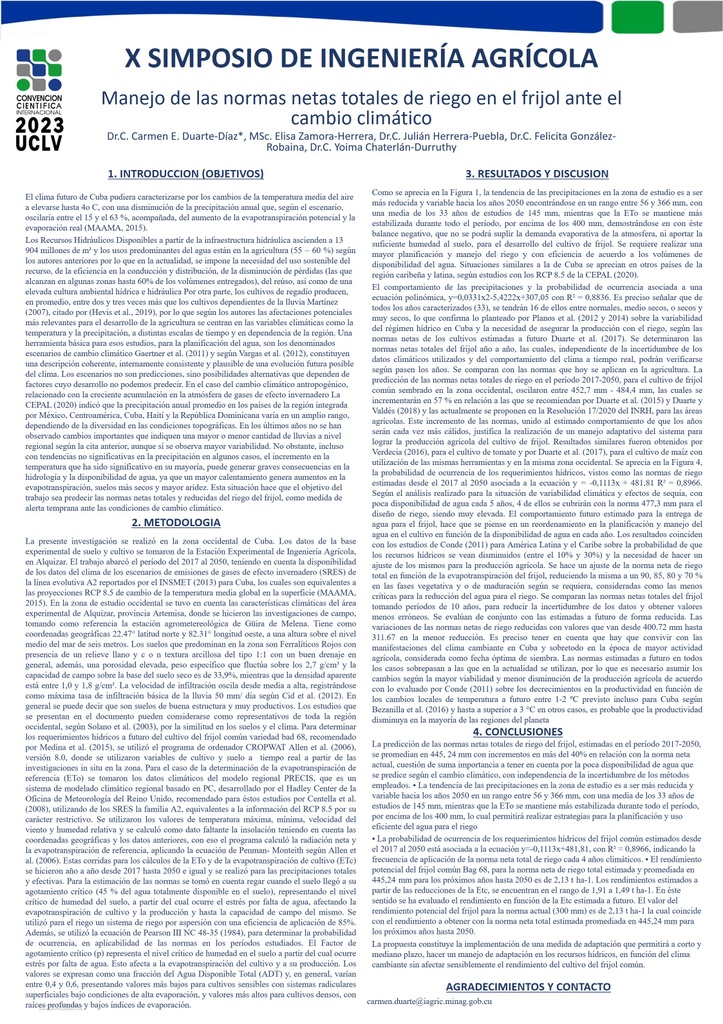Executive Secretary

9th International Scientific Conference on Agricultural Development and Sustainability
10th Symposium of Agricultural Engineering

Abstract
The need to particularize the differences in the net irrigation standards in force and those that are needed from now on, in crops of economic interest, according to the changing climate, defined the objective of the work to evaluate the management of irrigation of the total net standards and reduced bean cultivation as an adaptation measure in western Cuba. The climate data corresponded to the Providing Regional Climates for Impacts Studies regional model of the Echam A2 climate scenario for climate modeling and the reference evapotranspiration was estimated with the Cropwat program, as well as total and effective rainfall. The prediction of the total net irrigation norms in the period 2017-2050, for black bean bag 68, ranged between 452.7 mm - 484.4 mm, increasing between 57 and 61%, in relation to those in force in Cuba. According to the analysis of the probability of occurrence of the norms, 477.3 mm will have to be applied in four years of the five that have elapsed, according to y = -0.1113x + 481.81, for an R² = 0.8966, being very high and proposes as an adaptation measure the reduced standards estimated according to the critical periods of the crop with reductions of 90, 85, 80 and 70% of the evapotranspiration of the crop according to the availability of water and the guarantee of the production generated in each case, which was considered an early warning alternative for water planning in bean irrigation under climate change conditions
Resumen
La necesidad de particularizar en las diferencias de las normas netas de riego vigentes y las que se necesitan en lo adelante, en cultivos de interés económico según el clima cambiante, definió como objetivo del trabajo evaluar el manejo del riego de las normas netas totales y reducidas del cultivo frijol como medida de adaptación en la zona occidental de Cuba. Los datos climáticos correspondieron al modelo regional Providing Regional Climates for Impacts Studies del escenario climático Echam A2 para la modelación climática y se estimó la evapotranspiración de referencia con el programa Cropwat, al igual que las precipitaciones totales y efectivas. La predicción de las normas netas totales de riego en el período 2017-2050, para el frijol negro bag 68, osciló entre 452,7 mm - 484,4 mm, incrementándose entre 57 y 61 %, en relación a las que se encuentran vigentes en Cuba. Según el análisis de probabilidad de ocurrencia de las normas habrá que aplicar 477,3 mm en cuatro años de los cinco transcurridos, según y = -0,1113x + 481,81, para un R² = 0,8966, siendo muy elevada y se propone como medida de adaptación las normas reducidas estimadas en función de los períodos críticos del cultivo con reducciones del 90, 85, 80 y 70 % de la evapotranspiración del cultivo según la disponibilidad del agua y la garantía de la producción generada en cada caso, lo que se considera una alternativa de alerta temprana para la planificación del agua en el riego del frijol.
About The Speaker

Dra. Carmen Duarte Diaz

Discussion

